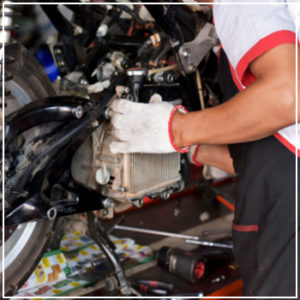
Although you may store your motorcycle in the garage for a week at a time when not in use, winterizing is a completely different process. When winter arrives in New England, your bike will be stored in a climate-controlled space for at least three months. Inactivity, moisture and pests can all damage your bike and by spring, what seemed fine in November may be covered in rust.
There are several factors to address as you winterize your motorcycle, but fuel degradation and oxidation need to be high on your list. Specifically, never keep old oil, fluids and gas for several months at a time. The solution will continue to degrade, gum up and separate, inviting corrosion in the process. In defense, flush out and replenish your bike’s fluids with the following factors in mind.
Limits of Ethanol-Based Fuel
Ethanol, found in gasoline, poses a few drawbacks for long-term motorcycle storage:
- It absorbs water with time
- The solution starts to separate
- Thick deposits accumulate on components of the internal fuel system
Over three or more months, old fuel causes parts to fail and may rust metal surfaces. In more extreme instances, the rust progresses to the carburetor and rubber parts may start to break down and crack.
On the other hand, an empty tank is not much better. Moisture can still build up inside, leading to rust and dried out seals. For these reasons, any gas and water currently in your motorcycle should be flushed out and replaced with fresh fuel and a stabilizer. Keep your tank fresh with the following options:
- Filling it with pure gasoline: It can be hard to find, but this ethanol-free option will protect a bike in storage for months.
- Add a fuel stabilizer: Even pure gasoline breaks down, causing varnish deposits to form in your tank. Before filling up your tank, mix a fuel conditioner in with ethanol-based gasoline to lubricate and protect the motorcycle’s internal parts.
Carburetors Cause Fuel to Evaporate
Carburetors mix air and fuel for efficient combustion. They release directly into the atmosphere, so any fuel left in your motorcycle will evaporate and leave thick deposits. This buildup prevents fuel from flowing through your bike the next time you go for a ride.
To prevent this, run a fuel treatment through its system to remove any buildup and contaminants, before you switch the petcock to “off” and drain the carburetor. From here, add fresh fuel with a stabilizer to your tank. Deposits may start to form, so be prepared to flush it again in the spring.
Coolant pH Changes
Consider draining your coolant for a couple of reasons. One, the fluid’s pH becomes significantly more acidic after a few years and, if you haven’t drained it in the past, now is the time to do it. Otherwise, older coolant can damage your engine’s interior and eat away at the gaskets and seals.
After draining, make sure to replenish the coolant. Without it, your motorcycle’s parts are susceptible to cold-weather damage, including expanding, drying out and cracking.
Brake Fluid Absorbs Water
It’s recommended you change your bike’s brake fluid at least once a year. More ideally, flush and replace it before putting your motorcycle in storage. With time, brake fluid absorbs water, which can corrode internal components and affect how the clutch functions. Particularly, if the ordinarily amber shade now looks darker, the fluid is too degraded to last the next few months in storage.
Old Oil Increases Engine Damage
In terms of engine performance, oil has two major jobs. For one, it acts as a lubricant for all moving parts. Secondly, its solution holds various deposits and transports them to the filter, where they are removed from circulation.
By default, old oil contains these particles. In storage, with the engine at a standstill, the debris separates from the oil and migrates to the surface. These substances are often very corrosive, turning into carbonic and sulfuric acid, and can scratch and damage your bike’s metal parts.
Draining and replacing your motorcycle’s oil offers a two-fold benefit, keeping your engine lubricated and removing damaging debris and gasses. Along with flushing and replacing your oil:
- Take one short ride before officially placing your bike in storage. This gets the oil flowing and lubricating your engine.
- Don’t forget about the filter. Replace it to remove any contaminants.
- Prepare to replace the oil again once spring arrives.
What are your tips for motorcycle winterization? Give us your suggestions on our Facebook page .
